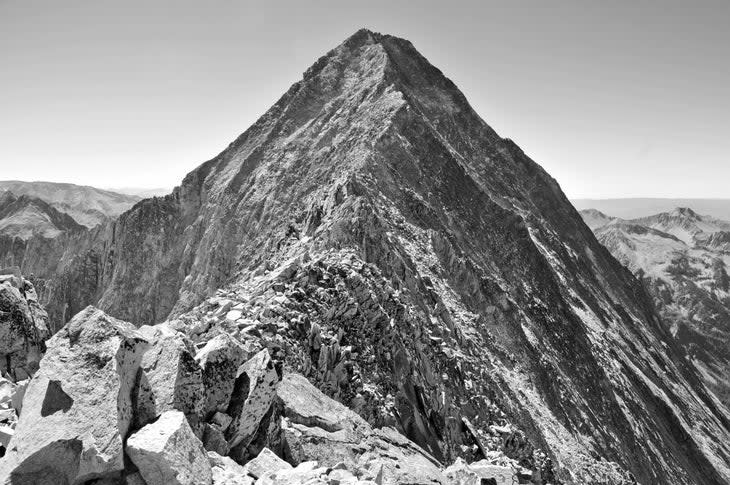One Dead, Others Rescued On Capitol Peak
This article originally appeared on Climbing
One climber was killed on Capitol Peak (14,137 feet) outside Aspen, Colorado, last week, while the mountain was the scene of other accidents--Mountain Rescue Aspen was called out to the Capitol valley four times in nearly as many days.
On September 3 a woman climbing alone fell approximately 900 feet after pulling on loose rock near Capitol’s summit, shortly after crossing the peak's famously exposed "Knife Edge" ridge. The following day another climber on the peak, who was dehydrated, improperly equipped, and far off-route, called for a rescue. After on-foot teams and a reconnaissance flight failed to locate him, he was finally spotted and evacuated by a Blackhawk helicopter sent from the National Guard. The next day, September 5, saw a 34-year-old hiker airlifted out from an elevation of 11,200 feet north of Capitol Lake after injuring his ankle. In a fourth incident, Mountain Rescue Aspen was called out to assist a group of hikers in distress on the peak's Ditch Trail approach.

Mountain Rescue Aspen (MRA) president Jordan White told Climbing that although last week's spate of rescues may seem shocking at first glance, the summer has thus far been fairly accident-free. "Until this fall, we've had a reasonably quiet summer," he said. "For whatever reason, these incidents often come in spurts. Two or three summers ago we had six or seven deaths on just Capitol, the rest of the peaks were quiet, then the next year Capitol was quiet. It comes and goes."
Last summer three members of MRA were seriously injured while on a body recovery on Capitol when hikers above them triggered rockfall. A later attempt to recover the body was abandoned when it was determined to be too risky, and the fallen climber’s body was left on the mountain.
Also Read: Death on Capitol Peak
Climbing Colorado's 14,000-foot peaks, or "14ers," is an increasingly popular pastime for locals and tourists alike, particularly during the summer months when the peaks are free of snow and ice, and many of the peaks are simple day hikes, making them accessible even for novice outdoor enthusiasts. While anyone can safely summit all of the Colorado 14ers without sustained technical climbing, some of the peaks, like Capitol, involve 4th or 5th class scrambling, and can become extremely technical, dangerous endeavors if climbers wander off-route or arrive unprepared.
Capitol is generally considered among Colorado's most difficult 14ers via its standard route, the Northeast Ridge. The route is relatively long (17 miles round trip), often requiring an overnight mission. Though the technical difficulty never reaches above 4th class, the final sections are extremely exposed, with significant quantities of loose rock. White notes that there hasn't been a clear increase in incidents on Capitol in recent years, even as 14er-hiking has boomed in popularity. "In general [in the last few years] we've certainly seen an increase in rescues, and specifically rescues on the 14ers," he said, "but I can't sit here and tell you it's an increase on Capitol--next year it'll be the Bells, or Pyramid, or Snowmass."
There are several factors common when it comes to the rescues and incidents White sees on Capitol and other Elk Range 14ers, but among the biggest is climbers having too little experience for the objective they're attempting. "Build up to the big ones," he says. "If there's a question in your mind as to whether you can safely climb Capitol, or any peak for that matter, then there is a qualified guide service out there that you need to use."
Another factor common to many accidents and rescues is climbers voluntarily splitting up with their partners, White says. This might occur because they disagree on the best route, because one climber is tired and wants to rest while the other is eager to push on, or for some other reason, but the result is the same. "Consistently for us, whether it's on the peaks or just in the backcountry, voluntary separation is a big one. When you split up, there's often a missed cue, stuff starts to go wrong. Just climb with a partner and don't separate from that partner."
Beyond this, White said that climbers should ensure they come prepared with the 10 Backcountry Essentials (navigation, headlamp, sun protection, first aid, knife, fire-starting gear, emergency shelter, extra food, extra water, and extra clothes).
He added that carrying an inReach or other form of satellite communication device is crucial to staying safe in the backcountry, whether on a peak or simply backpacking. Many rescues would become body recoveries if the individual in question hadn't been able to call for help in time.
For exclusive access to all of our fitness, gear, adventure, and travel stories, plus discounts on trips, events, and gear, sign up for Outside+ today.

